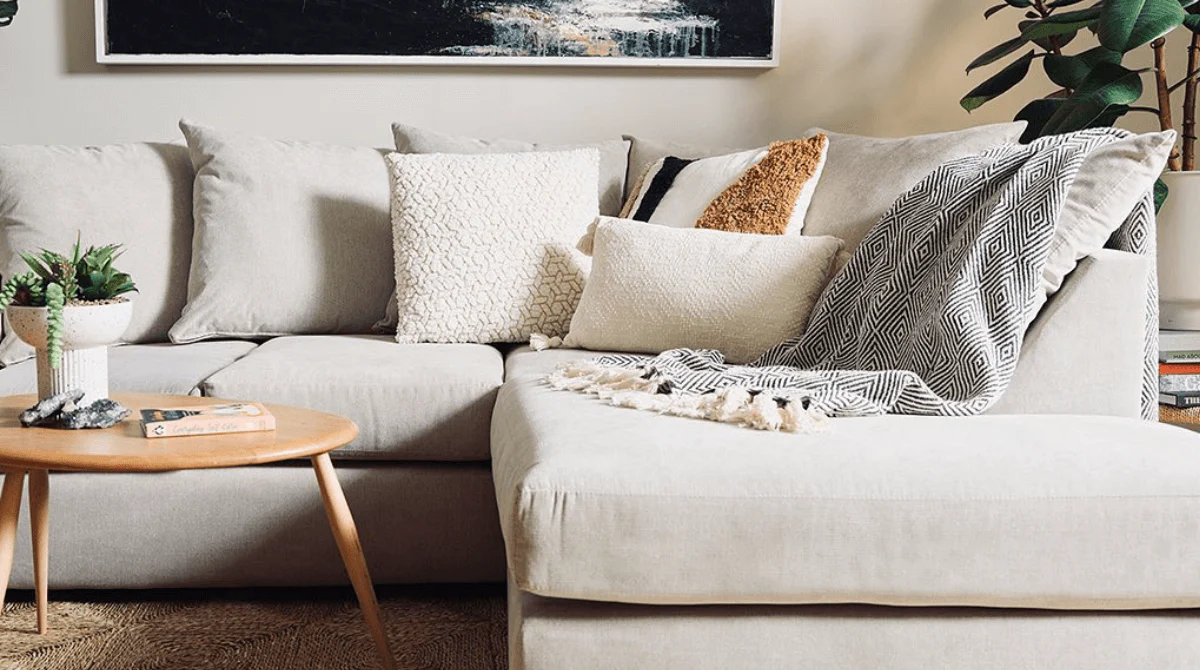Keeping your sofa clean not only enhances the appearance of your living space but also extends the life of your furniture. Whether you’re dealing with everyday dust or stubborn stains, this guide will walk you through effective methods to clean your sofa, tailored for UK households
Table of Contents
- Understanding Your Sofa’s Fabric
- Essential Cleaning Supplies
- Routine Maintenance
- Spot Cleaning Techniques
- Deep Cleaning Methods
- Dealing with Specific Stains
- Cleaning Different Sofa Materials
- Drying and Aftercare
- Preventive Measures
- When to Seek Professional Help
Understanding Your Sofa’s Fabric

Before you begin cleaning, it’s crucial to identify your sofa’s fabric type. Most sofas come with a care label indicating the appropriate cleaning methods:
W: Water-based cleaners are safe.
- S: Use solvent-based cleaners only.
- WS: Both water and solvent-based cleaners are acceptable.
- X: Vacuum only; professional cleaning recommended
Check the label, usually located under the cushions or on the underside of the sofa, to determine the suitable cleaning approach
Essential Cleaning Supplies

Gather the following items to ensure an efficient cleaning process:
- Vacuum cleaner with upholstery attachment
- Soft-bristled brush
- Microfibre cloths
- Mild dish soap
- White vinegar
- Baking soda
- Spray bottle
- Bucket of warm water
- Protective gloves
Routine Maintenance
Regular maintenance helps prevent the buildup of dirt and prolongs your sofa’s lifespan.
Vacuuming
Use the upholstery attachment to vacuum your sofa weekly. Pay special attention to crevices and seams where dust and crumbs accumulate
Fluffing Cushions
Fluff and rotate cushions regularly to maintain their shape and ensure even wear
Spot Cleaning Techniques

Address spills and stains promptly to prevent them from setting.
Blotting Spills
Immediately blot any spills with a clean, dry cloth. Avoid rubbing, as this can spread the stain
Homemade Cleaning Solution
For water-safe fabrics (labelled ‘W’ or ‘WS’), mix a solution of warm water and a few drops of mild dish soap. Dampen a microfibre cloth with the solution and gently blot the stained area. Rinse with a cloth dampened with clean water and blot dry.
When cleaning your sofa, it’s also a good time to evaluate whether your current setup meets your space and style needs. If you’re considering an upgrade, explore our collection of 7 seater sofas for spacious comfort, ideal for larger families or entertainment areas.
Vinegar Solution
Mix equal parts white vinegar and water in a spray bottle. Lightly mist the stained area and blot with a clean cloth. This method is effective for removing odours and light stains
Deep Cleaning Methods
Deep cleaning is recommended every 6–12 months, depending on usage.
Baking Soda Treatment
Sprinkle baking soda over the entire sofa and let it sit for 20–30 minutes to absorb odours and loosen dirt. Vacuum thoroughly using the upholstery attachment
Steam Cleaning
If your sofa’s care label permits, use a steam cleaner to deep clean the fabric. Steam cleaning helps eliminate bacteria and refreshes the upholstery. Always test a small, inconspicuous area first to ensure colour fastness.
For slightly more compact living rooms, our 6 seater sofas strike the perfect balance between style and seating capacity.
Dealing with Specific Stains

Different stains require tailored approaches:
Ink Stains
Dab the stain with a cloth dipped in rubbing alcohol. Blot gently until the ink lifts. Avoid rubbing, which can spread the ink
Grease Stains
Sprinkle baking soda or cornstarch on the stain and let it sit for 15 minutes to absorb the grease. Vacuum the powder and blot the area with a cloth dampened with a mild soap solution
Wine Stains
Blot the stain immediately with a clean cloth. Apply a mixture of equal parts white vinegar and water, then blot with a dry cloth.
Cleaning Different Sofa Materials

Fabric Sofas
Follow the spot cleaning and deep cleaning methods outlined above. Always check the care label before applying any cleaning solution.
Leather Sofas
- Dust regularly with a dry cloth.
- Clean with a damp cloth and a small amount of mild soap.
- Dry immediately with a clean towel.
- Apply a leather conditioner every 6–12 months to maintain suppleness.
Suede Sofas
- Use a suede brush to remove surface dirt.
- For stains, use a suede eraser or a white pencil eraser.
- Avoid using water, as it can damage suede.
Drying and Aftercare

After cleaning, allow your sofa to air dry completely. Open windows or use fans to speed up the drying process. Avoid using a hairdryer or placing the sofa in direct sunlight, as this can cause fading or damage to the fabric.
Preventive Measures
- Use sofa covers or throws to protect the upholstery.
- Keep pets off the furniture or use pet-friendly covers.
- Avoid eating or drinking on the sofa to prevent spills.
- Place the sofa away from direct sunlight to prevent fading.
5 Pro Tips to Clean Your Upholstery at Home

Tip 1: Check the Cleaning Code First
Hey, it’s Brandon and here’s five tips to clean your upholstery like a pro. Let’s get started! Tip number one is to check the clean code on the item’s tag. Now, you might be thinking, “I have no idea what you’re talking about — I’ve never heard of that before.” It’s pretty common! Most pieces of furniture, if they have a tag, will have something called a clean code. The clean code is usually a letter:
- If it’s a W, that means it can be cleaned with water.
- If it’s an S, that means it has to be dry cleaned with a solvent.
- If it’s an S/W, that means you can clean it with water or a solvent-based cleaner.
Some pieces (though rare) will have an X — that means do not try to clean this on your own. Consult a professional or the manufacturer for the best guidance.
But what if your piece doesn’t have a tag? That’s a great question. I suggest two things:
- Do a quick Google search of the manufacturer’s name along with “how to clean,” which usually helps find proper care instructions.
- Call the retailer where you bought the piece they usually have it on file.
Alternatively, test a small hidden area of the furniture using a water-based or solvent-based cleaner. Spray a little on the back side or underside of a cushion and see how it reacts and dries. If it dries well, you’re good to go. But if you notice browning, water marks, or shrinking proceed with caution.
And if you’re looking to match a modern aesthetic, our range of grey corner sofas offers both elegance and functionality, blending seamlessly into contemporary interiors.
Tip 2: Vacuum Thoroughly Before Cleaning
Tip number two is to thoroughly vacuum the piece before you start cleaning. Dirt and dust build up in upholstery over time, so you want to remove as much of it as possible using a dry vacuum. This makes your wet cleaning far more effective.
Tip 3: Use the Right Cleaner for the Fabric Type
Tip number three is to choose the right cleaner. Thanks to the clean code, it’s easier to know what to use.
- For water-safe fabrics, mix 1 cup of rubbing alcohol, 1 cup of water, and a few drops of Dawn dish soap. This DIY solution cleans effectively without damaging the fabric.
- For solvent-based cleaning, I’ve linked a product in the description below on how to use it.
Tip 4: Clean and Extract the Right Way
Tip number four is to clean and extract — and this part is usually very satisfying. Start by spraying the cleaner on the fabric and scrubbing it gently with a soft-bristle brush or towel. Then, use a spotter or carpet cleaning machine with an upholstery attachment, using water only in the machine. Work in sections, flushing the entire piece. This removes both the cleaner’s residue and deeply embedded dirt.
What if you don’t have an extractor? No problem. Fill a spray bottle with warm water, mist the spot, and wipe it with a dry microfiber towel. This will lift the dirt into the towel. It won’t work as deeply as a spot cleaner, but it will still give much better results than doing nothing.
Tip 5: Dry the Upholstery as Quickly as Possible
Tip number five is to get the piece dry fast. Depending on the season, you can open windows or use a box fan, ceiling fan, or snail fan. Airflow is key — it helps moisture evaporate quickly. If your sofa has double-sided cushions or pillows, stack them upright so each surface gets airflow and dries evenly.
When to Seek Professional Help

If your sofa has stubborn stains, is heavily soiled, or is made of delicate fabric, consider hiring a professional upholstery cleaning service. Professionals have the expertise and equipment to clean your sofa safely and effectively.
By following this comprehensive guide, you can maintain a clean and fresh sofa, enhancing the comfort and appearance of your living space. Regular care and prompt attention to spills will ensure your sofa remains a cosy centrepiece in your home for years to come





